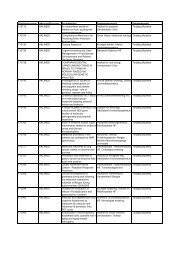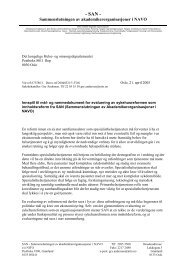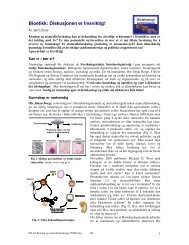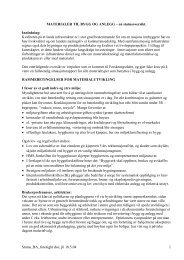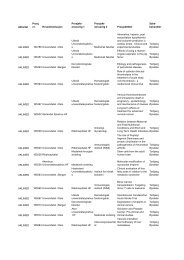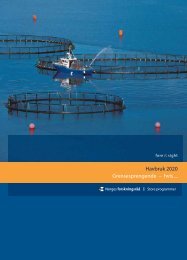A Revolution in R&D
A Revolution in R&D
A Revolution in R&D
Create successful ePaper yourself
Turn your PDF publications into a flip-book with our unique Google optimized e-Paper software.
26<br />
genetics-based form of pharmacogenomics (see<br />
sidebar, “Pharmacogenomics—Some Def<strong>in</strong>itions”),<br />
and comes <strong>in</strong>to play later, <strong>in</strong> the development<br />
phase: it <strong>in</strong>volves predict<strong>in</strong>g the efficacy and side<br />
effects of candidate drugs.<br />
The data explosion detonated by genomics technology<br />
has created vast amounts of genetic <strong>in</strong>formation,<br />
ready for sift<strong>in</strong>g. The f<strong>in</strong>d<strong>in</strong>gs of the<br />
Human Genome Project and related endeavors are<br />
merely the start<strong>in</strong>g po<strong>in</strong>t. The ultimate goal is to<br />
elucidate the genetic basis of human disease and<br />
drug response. In the short term, genetics research<br />
will enable scientists to predict disease susceptibility<br />
and likely drug response <strong>in</strong> <strong>in</strong>dividuals; <strong>in</strong> the<br />
longer term, it should help to improve the quality<br />
of pharmaceuticals and medical diagnoses.<br />
PHARMACOGENOMICS—SOME DEFINITIONS<br />
Pharmacogenomics is the use of genomics<br />
approaches to elucidate drug response. There are<br />
three relevant approaches: via DNA, via RNA, and<br />
via prote<strong>in</strong>s, and three correspond<strong>in</strong>g forms of pharmacogenomics:<br />
pharmacogenomics us<strong>in</strong>g genetic<br />
approaches (or pharmacogenetics), expression profil<strong>in</strong>g<br />
(or expression pharmacogenomics), and proteomics<br />
(or proteomic pharmacogenomics).<br />
Pharmacogenetics predicts patients’ drug response<br />
by analyz<strong>in</strong>g the genetic variations <strong>in</strong> their DNA. It is<br />
the form of pharmacogenomics discussed <strong>in</strong> the<br />
ma<strong>in</strong> text here.<br />
Expression pharmacogenomics predicts patients’<br />
drug response by analyz<strong>in</strong>g their RNA levels—specifically,<br />
by compar<strong>in</strong>g the amounts of RNA found <strong>in</strong><br />
different samples to determ<strong>in</strong>e which genes are<br />
expressed at different levels. An example: a research<br />
group at The Whitehead Institute study<strong>in</strong>g two very<br />
similar leukemias (AML and ALL) has observed a<br />
dist<strong>in</strong>ct difference <strong>in</strong> expression levels of specific<br />
genes, and thereby provided a quick and reliable<br />
method for differentiat<strong>in</strong>g them. Patients are now<br />
less at risk of be<strong>in</strong>g misdiagnosed and be<strong>in</strong>g given<br />
Atta<strong>in</strong><strong>in</strong>g the short-term goal is, conceptually, simple<br />
enough. The genetic codes of <strong>in</strong>dividuals differ<br />
<strong>in</strong> t<strong>in</strong>y, but sometimes decisive, details. By compar<strong>in</strong>g<br />
an <strong>in</strong>dividual’s genetic variations aga<strong>in</strong>st the<br />
“standard” genome, scientists should be able to predict<br />
whether that <strong>in</strong>dividual is at risk for a specific<br />
disease, and, if so, how well suited he or she is to a<br />
particular drug therapy—the work respectively of<br />
disease genetics and pharmacogenetics.<br />
The two approaches benefit R&D economics <strong>in</strong> different<br />
ways. Disease genetics will improve efficiency<br />
<strong>in</strong> target discovery and, by lead<strong>in</strong>g to the discovery<br />
of particularly high-quality targets, will br<strong>in</strong>g about<br />
improved success rates <strong>in</strong> validation and downstream.<br />
Pharmacogenetics, by enabl<strong>in</strong>g scientists to<br />
select patients more appropriately for cl<strong>in</strong>ical trials,<br />
an <strong>in</strong>correct, and possibly lethal, drug treatment: <strong>in</strong><br />
effect, the test screens for adverse drug response.<br />
Expression pharmacogenomics seems to be mov<strong>in</strong>g<br />
from academic studies and biotechs <strong>in</strong>to more ma<strong>in</strong>stream<br />
pharmaceutical R&D. Witness the recent purchase<br />
by Merck and Co. of Rosetta Inpharmatics, a<br />
biotech founded specifically to develop expression<br />
pharmacogenomics.<br />
F<strong>in</strong>ally, proteomic pharmacogenomics predicts<br />
patients’ drug response by analyz<strong>in</strong>g their prote<strong>in</strong><br />
levels—specifically, by compar<strong>in</strong>g prote<strong>in</strong> read<strong>in</strong>gs<br />
<strong>in</strong> different tissue samples to identify prote<strong>in</strong>s that<br />
differ either <strong>in</strong> structure or <strong>in</strong> expression levels.<br />
Consider the example of an aberrant fusion of two<br />
prote<strong>in</strong>s called Bcr and Abl, which occurs <strong>in</strong> more<br />
than 95 percent of patients with CML (chronic<br />
myeloid leukemia, which accounts for about 20 percent<br />
of all cases of adult leukemia). This aberrant<br />
fusion prote<strong>in</strong> is present only <strong>in</strong> cancer cells. It dist<strong>in</strong>guishes<br />
itself from its normal counterparts by its<br />
<strong>in</strong>creased size. It can be used not only to monitor the<br />
progression of the disease but also to test whether<br />
Gleevec, a revolutionary new drug, would provide an<br />
effective therapy.



